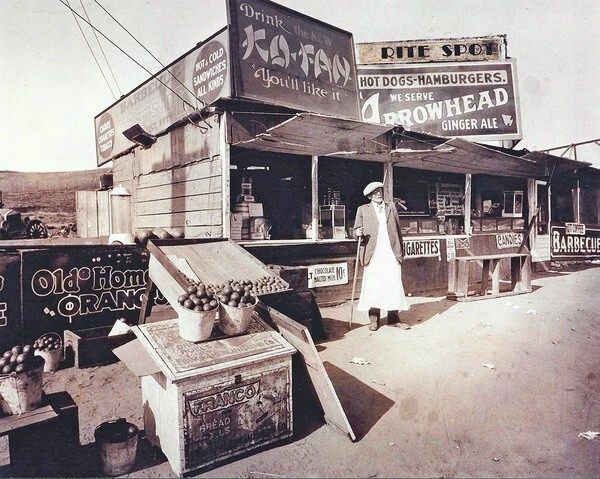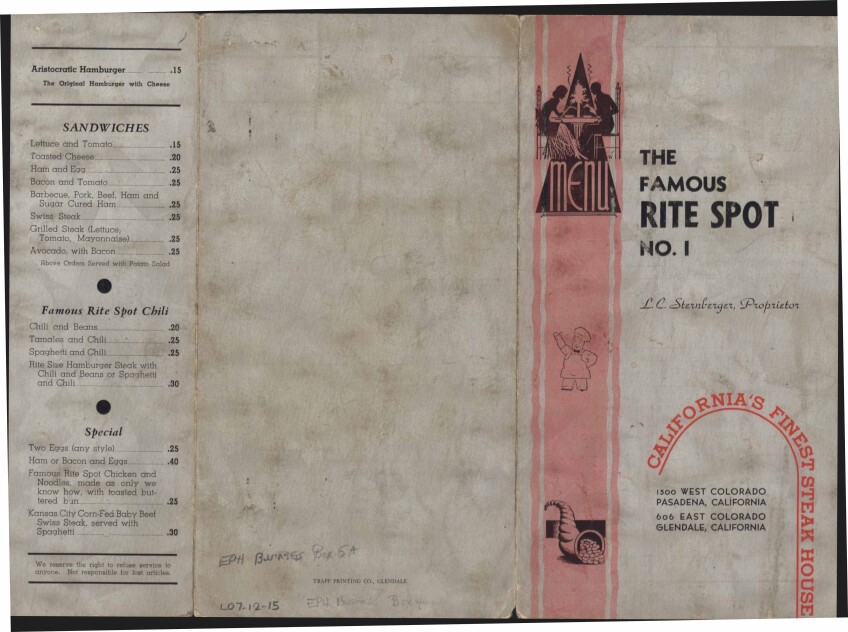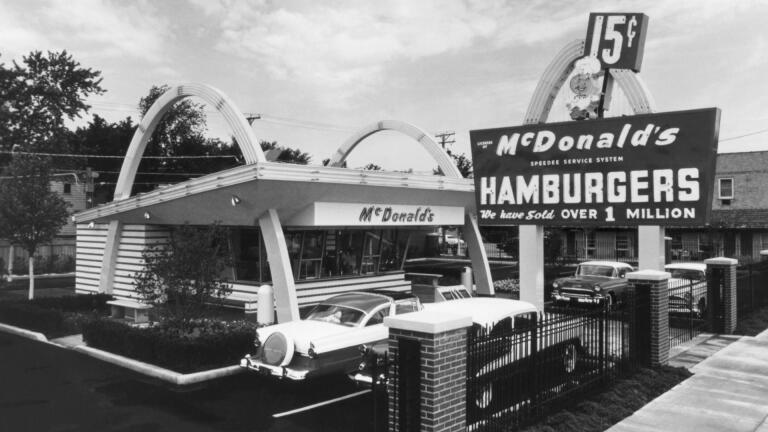Pasadena Claims To Be The Home Of The Cheeseburger — But There's Beef

This article was originally published by LAist on January 19, 2024.
This year Pasadena hosts its annual Cheeseburger Week, Jan. 21 to 27. It's been a regular event for more than a decade, but this year is particularly notable — the city says it's 100 years since the national icon was born.
The week is hosted in honor of Lionel Sternberger, who, according to local lore, created the beloved cheeseburger at his roadside stand off Route 66 in Pasadena in the 1920s.
But did Sternberger really create the cheeseburger? And what year? And why? While the Pasadena Chamber of Commerce believes it occurred in 1924, other sources give different dates. Other states also claim the honor. It’s one of SoCal’s numerous unsolved mysteries.
Burger History
The course of food history is often murky at best. According toThe Great American Burger Book, by George Motz, it is believed burger meat (originally raw mutton) originated in the 13th century Mongol empire, before Russian and German immigrants brought their chopped beef version to America in the 19th century. It was in the go-go U.S.A. that a sizzling burger was probably slapped between two slices of bread, with multiple people claiming the honor sometime between 1885-1900.
But there is no ambivalence about the fact that 20th century Southern California is the birthplace of fast food. Due to our early adoption of cars, freeways, commutes and our love of a cheap, greasy meal, McDonald's,Taco Bell,Fatburger and In-N-Out, among others, were all started by savvy, entrepreneurial Southern Californians. And Lionel Sternberger was a true forerunner to these revolutionary restaurateurs.
Sternberger’s Road Stand
The earliest known version of Sternberger’s creation of the cheeseburger was recently discovered by food historian Andrew Smith, author of Hamburger: A Global History. It is in an article in The Pasadena Post, a now defunct newspaper. Published July 23, 1931, it sheds light on Sternberger’s early life and innovative ideas.
Lionel Sternberger was born in New York City in 1907. Soon the Sternberger family was off to booming SoCal, and Lionel attended grade school in Eagle Rock before attending high school in Pasadena. A natural born entrepreneur, he started a cider stand at the age of 12 and was running a grocery store at the age of 15.
According to the Pasadena Post, in 1927, an act of kindness led Sternberger to his most famous acquisition — 1500 West Colorado Boulevard (part of the legendary Route 66), just west of the Colorado Street Bridge:
The young man started on the present enterprise in 1927, as the result of an interesting incident. On the approach to Pasadena, he halted his automobile and gave a lift to a waysider who wanted to get off at the soft drink stand at the crown of Colorado Street near Annandale Golf Links. Sternberger knew this location well — he and his father, years before, sold fruit on the same spot.Pasadena Post
The road was already lined with quick serve options for harried commuters.
"There was a row of food stands offering everything from burgers and fries to Chinese food," says Paul Little, president of the Pasadena Chamber of Commerce and Civic Association in an interview over email. "They catered to drivers heading into Eagle Rock and other parts of L.A. and toward Glendale."
Sternberger reached the little stand, which a 1937 issue of Western Restaurants claims was called Hinky Dink Barbecue Stand. The Post reported:
On reaching the top of the hill, Sternberger drove his car to the doorstep so his passenger would not have to wade in the mud left by the rain the night before. Sternberger engaged the owner of the soft drink stand in conversation, with the result he swapped his car for the stand.
He renamed the stand (little more than a cooking shack) the Boulevard Stop, before changing its name to The Rite Spot. But the going was rough, and Sternberger’s stand was only bringing in around $2 a day.
Adding the Cheese
Stories diverge wildly over what prompted Sternberger to add a slice of cheese (kind unspecified) on the hamburger. According to The Pasadena Post, an unnamed friend suggested the struggling Sternberger try something new that would set his stand apart.
"Together the pair 'invented' a new hamburger sandwich," the Post reported, "which included a slice of cheese, a food never before tried on such a sandwich. It was very tasty."
Sternberger’s nephew Don heard another story from his father, Van, who would join Lionel in the family business.
"Lionel was a big eater," he told the Los Angeles Times in 2012. "One day he just decided he wanted a hamburger with cheese on it and started doing it. That's how my dad described it to me. My dad was proud of it. I tried once to get him to go to In-N-Out with me and he wouldn't."
(There are also other versions, like Sternberger putting "everything" on a burger as requested by an enthusiastic customer, including cheese, and Sternberger burning one side of a patty, which he covered up with a cheese slice.)
According to The Pasadena Post, Sternberger was initially wary of promoting this new burger with cheese, due to cheese costs at the time. However, he tried it out one day on two faithful customers — and they loved it.
"The next day," The Pasadena Post reported, "an automobile with six passengers halted at the door. The driver asked: 'Is this where hamburgers with cheese are served?'"
The customers loved the newfangled cheeseburger so much they ordered seconds. Soon The Rite Stop cheeseburgers were all the rage in Pasadena, and Sternberger was banking $400 a day.
"As a Muir Tech student in Pasadena in the late '20s and early '30s," Pasadena native Jim Horbuckle recalled, per Smith, “the big treat was to take our dates to Lionel Sternberger’s Rite Spot — delicious hamburgers with cheese — 15 cents, a glass of cider, 10 cents. The total bill was $1."
An undated menu for The Rite Spot shows just how important this new edition to the menu was. The first item on the menu, it was called the "Aristocratic Hamburger" and billed as "the original hamburger with cheese." The rest of the menu was standard Americana fare — chili and beans, Steak Lover’s Delight, Baked Alaskan Shrimp and Pie á la Mode.

By 1931, Sternberger was prospering. The Rite Spot expanded to another brick-and-mortar eatery in Pasadena, and also opened locations in Glendale and Highland Park. With his newfound fortune, Sternberger reportedly built a large house in the Pasadena neighborhood of Annadale, which he shared with his mother.
The Sternberger family continued in the restaurant business for decades. When Sternberger died in 1964, Time Magazine credited him as the inventor of the cheeseburger (although it stated he had created it while working at a stand owned by his father).
Rivals to the crown
However, there are other claimants to the cheeseburger throne. According to George Motz, a 1928 menu from Odell's Restaurant in South Los Angeles features a chili cheeseburger. Kaelin's Restaurant in Louisville, Kentucky, has long asserted that their founder Carl Kaelin created the cheeseburger in 1934. And Louis Ballast of Humpty Dumpty Drive-In in Denver had the name "cheeseburger" trademarked in 1935.
There has been some discussion back and forth in a friendly rivalry.Paul Little, president of the Pasadena Chamber of Commerce and Civic Association
"There has been some discussion back and forth in a friendly rivalry," Little says of the competing claims. "Menus and other historical artifacts support the Rite Spot as being the originator of the hamburger with cheese. Sternberger did not call it a cheeseburger, which is what the others who claim to be originators use."
Indeed, if the newly uncovered Pasadena Post article is accurate, it seems the main competition for "first cheeseburger" may only be the long-gone Odell's. But Pasadena has embraced the legend of Lionel Sternberger and uses it today to celebrate the city’s thriving restaurant scene.
"In 2011, as part of California Restaurant Month, we started hosting Cheeseburger Week in January," Little says. "We have done that every year since. It was a take-out version during the pandemic."
In 2017, a marker was placed at the site of the first The Rite Spot, into the sidewalk outside of the LA Financial Credit Union at 1520 W. Colorado Blvd. It tells yet another version of the story.
"On this site in 1924," it reads, "sixteen-year-old Lionel Sternberger first put cheese on a hamburger and sold it to a customer, thereby inventing the cheeseburger. The 'Aristocratic Burger' at the Rite Spot is the first instance of a hamburger with cheese being served to a customer."
Whatever the case, we can all agree the end result was delicious — and well worth celebrating during Cheeseburger Week.





